Blast Off: New Coatings at Power Plant Turbine
January 12, 2023 •Corrosion CONTROLLED, Corrosion Essentials, Coatings
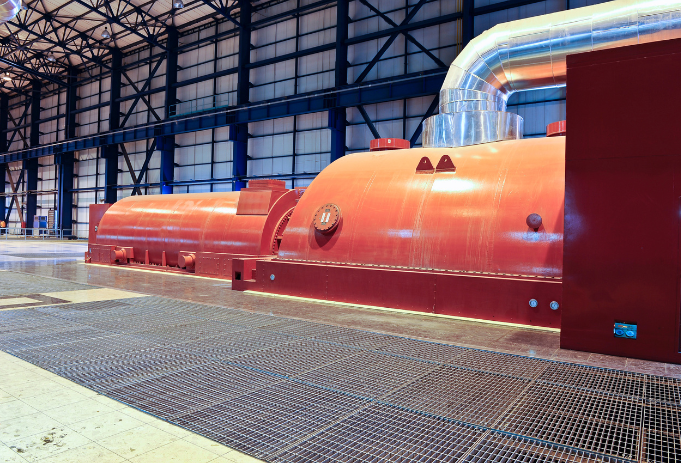
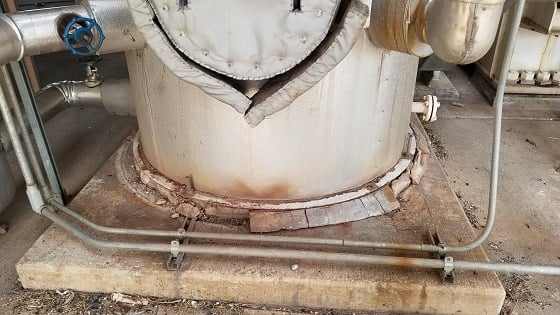
For the five-person crew from Belzona distributor Industrial Repair Technology, led by General Manager Jason Kraft, the coating work at a clean gas-driven power plant was quite detailed. The project included two inlet ducts and bell mouths for a turbine intake at Dogwood Energy in Pleasant Hill, Missouri. Each inlet was approximately 1,000 square feet (92.3 m2) and had to be accessed, prepped, and coated before the crew could call it complete.
It took the crew one week to prep and one week to coat each of the turbines — but this project would prove not to be as straightforward in reality as it sounded on paper.
Safety in Small Spaces
The contracting company, based in suburban Kansas City, Missouri, is a certified dealer of and applicator for Belzona materials, with United States headquarters in Miami, Florida. The turbines required the use of Belzona 5892. But first they had to get access to the area.
Because the turbines were considered confined spaces, the crew not only had to have training, but they also had to wear harnesses for extraction and use a hole monitor at all times. The training included Occupational Safety & Health Administration (OSHA) 10 for crew members and OSHA 30 for the foremen and safety officer. In addition to that, they had to complete the local plant safety training process and monitor the air to meet OSHA’s permit-required confined spaces.
The crew also had to have hot work permits if any sparks were expected to be created. The inlet areas were used for wet compression and fogging projects, and that’s another reason why these specific materials were chosen for this project: The two-part 5892 epoxy is able to withstand high temperatures up to 203 °F (95.0 °C). Although equipment at the facility runs hot, during the project the turbines were locked out, tagged out, and were completely deenergized when the crew was on site.
Prep and Coat
When it came to the actual application, the Industrial Repair Technology crew had to start by preparing the galvanized steel. They protected other surfaces with heavy plastic before using Schmidt by Axxiom 3.5-cubic-foot (0.1 m3) blast pots and a Radex airless filter along with Black Beauty coal slag. That was to create an average 3-mil (76.2 microns) profile and in adherence to NACE No. 1/Society for Protective Coatings (SSPC) Surface Preparation (SP) 5: White Metal Blast Cleaning standard.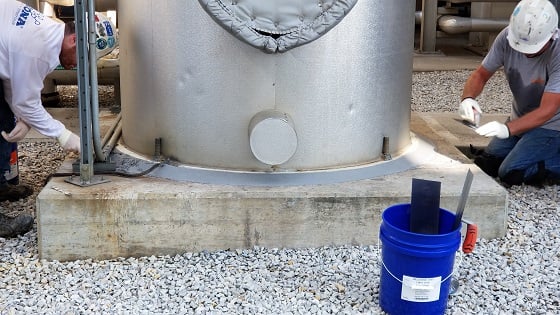 The crew was sure to wear proper protective equipment (PPE) throughout the job, including non-cut gloves, steel-toed boots, safety glasses, and hard hats. If any member of the crew was working on the site-provided green-tagged scaffolding, at 3 feet (0.9 m) or more off the ground, he or she had to wear Guardian fall protection gear.
The crew was sure to wear proper protective equipment (PPE) throughout the job, including non-cut gloves, steel-toed boots, safety glasses, and hard hats. If any member of the crew was working on the site-provided green-tagged scaffolding, at 3 feet (0.9 m) or more off the ground, he or she had to wear Guardian fall protection gear.
The crew also paid particularly close attention to safety gear during the prep stage, where they wore Allegro Nova helmets. They held daily safety meetings and maintained jobsite hazard analysis documentation.
Once the surfaces were prepped and wiped down, the crew was able to move on to the coatings. Using wet film thickness gages, the crew used brushes and a Titan 440 airless sprayer to apply a total average of 20 mils (508.0 microns) dry film thickness. That was installed in two layers at about 10 mils (254.0 microns) each. Once cured, the crew used a sponge test and pull off gage, per a NACE Level 3 report.
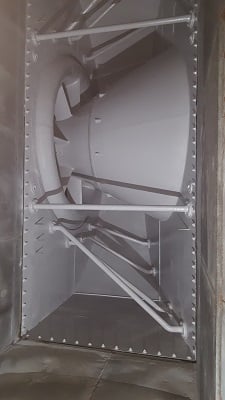 The epoxy is solvent-free and, therefore, didn’t require a respirator when applying. But because this project took place in the Midwest in September and October, which run a bit colder than earlier months, the crew was sure to keep materials in a controlled environment at the jobsite’s designated staging area.
The epoxy is solvent-free and, therefore, didn’t require a respirator when applying. But because this project took place in the Midwest in September and October, which run a bit colder than earlier months, the crew was sure to keep materials in a controlled environment at the jobsite’s designated staging area.
Solution That Saves
According to Kraft, several crew members were “vital in the application process”: Stephen Palmer, Mark Greathouse, Ben Bruce, and Jon Bruce. After cleanup, which included using Blastrac BDC-1216 high-efficiency particulate air (HEPA) vacuums to finish removing any spent abrasives, the Industrial Repair Technology crew was able to call it a day.
“We delivered back an amazing long-term solution that has led to many more applications at the same power plant,” Kraft said. According to the general manager, when compared to other products and services, this crew was able to deliver a solution that saved the client around $60,000. Those are potentially big savings from a seemingly small solution.
This article by Stephanie Marie Chizik was originally published online for CoatingsPro Magazine. Photos courtesy of Belzona. Republished with permission.
Want to learn more about Coatings at a Power Plant Turbine? Keep reading to find out more.
Visit the AMPP Booth @ World of Concrete 2023
Part knowledge, part equipment, part connections—World of Concrete is 100% of what you need to keep grinding it out through disruptions to the supply chain, safety, and beyond. Get your hands on advanced technology and machinery, access the newest training and techniques in concrete and masonry, and build momentum for another unstoppable year. Visit the AMPP Booth (#S11639) January 17 - 19, 2023 in Las Vegas, Nevada.
AMPP Annual Conference + Expo Has It All!
AMPP Advance Registration Ends January 19th!
You’re Invited to the largest and most comprehensive global industry event focused on corrosion, coatings, materials, and new technologies from around the world!
This one-of-a-kind event brings together experts and professionals from around the world, a full schedule of real-world workshops and forums, and the ability to participate in meetings that shape the future of the industry. Register by January 19th to get the best deal!
More Industry Resources
Coating Work in Nuclear Power Plants
At a Nuclear Power Plant (NPP), the security, training, and safety requirements are quite complex when compared to industrial or commercial facilities. Security requirements start with the completion of an extensive personnel qualification and employment history questionnaire followed by background screening, and security program training. Safety in a NPP includes nuclear safety in addition to the typical industrial safety training. Check out this Conference Paper that highlights the coating work in nuclear power plants.
Calling all AMPP Members, Certification Holders, Volunteers, & Customers
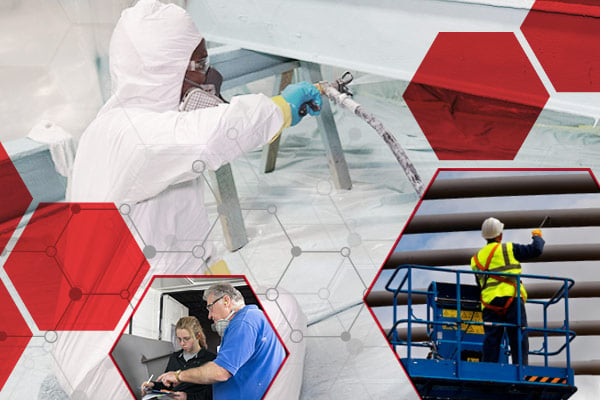 The AMPP Marketing Department is looking for high quality images and video clips of those in the AMPP community actively working in their jobs and careers.
The AMPP Marketing Department is looking for high quality images and video clips of those in the AMPP community actively working in their jobs and careers.
Whether you work in the field, in a shop, in an office, lab or a plant, wherever you are doing what you do, we want to see images of you out in the world.
Images and videos will be used in a variety of campaigns in 2023 that will highlight the offerings of AMPP as well as the individuals who give AMPP Purpose.
Click the link below to learn more and submit your images and videos today!
https://lnkd.in/geg2xEi8
Bob Chalker on His Retirement and AMPP’s Path Forward Bob Chalker, CEO of AMPP, discusses his decision to retire in July 2023 and what the path forward looks like for our corrosion control and protective coatings organization. Topics include the motivations for his decision; the process of naming a replacement; highlights from Chalker’s 13-year tenure at AMPP and NACE International; and the legacy he leaves behind. Listen Now
Become a member today and join this distinctive global community of professionals concerned with a safer, protected, and more sustainable world through the advancement of corrosion control and protective coatings. Click here to see what's new and what you've been missing!
NACE and SSPC are now AMPP, The Association for Materials Protection and Performance. Join AMPP Today!
Get Updates
Featured Articles
Categories
- 2024 Olympics (1)
- 2024 Water Resource Development Act (1)
- Abrasive Blasting (1)
- Advanced coating materials (9)
- advanced coatings (1)
- Advanced Corrosion Control in Oil and Gas Industry (2)
- Advocacy (3)
- AI (2)
- Aircraft (1)
- Alkanization (1)
- AMPP (4)
- AMPP Annual Conference + Expo (5)
- ampp awards (1)
- ampp certification (2)
- Ampp Chapters (1)
- AMPP conference (1)
- AMPP logo (1)
- Ampp Membership (2)
- Ampp Standards (3)
- ampp training (2)
- Amusement parks (4)
- Architectural (1)
- Architectural Coatings (2)
- argonne national laboratory (1)
- Artificial Intelligence (1)
- Asset integrity (12)
- Asset maintenance (3)
- Asset Protection (1)
- awards (3)
- B2B Marketing (1)
- Bim Software (1)
- Biodeterioration of materials (5)
- Biofouling (4)
- Blasting (1)
- Bridges (4)
- career advancement (3)
- career development (2)
- cathodic protection (2)
- Cathodic Protection-CP (16)
- Ceramic epoxies (1)
- Certification (3)
- certification study guide (1)
- Chemical Injection (1)
- CIP (1)
- Civil Engineering (1)
- clean energy (1)
- Coating inspector (2)
- coating inspector job roles (1)
- Coating inspector jobs (2)
- Coating inspector program (2)
- Coatings (18)
- Coatings Application (3)
- coatings certification (1)
- Coatings failures (2)
- Coatings Industry (2)
- coatings inspection (1)
- Coatings inspector (2)
- Coatings measurement and inspection (9)
- coatings project management (1)
- Coatings Systems (1)
- Cold stress (1)
- Concrete (13)
- Concrete corrosion (1)
- concrete cracking (1)
- Conference and Events (2)
- Corrosion (26)
- Corrosion Basics (5)
- corrosion certification (1)
- Corrosion Control (17)
- Corrosion Control and Management (23)
- Corrosion detection (1)
- corrosion engineering (1)
- Corrosion Essentials (20)
- Corrosion Inspection (1)
- Corrosion Management (1)
- Corrosion Meaning (1)
- corrosion mitigation (1)
- corrosion of steel (1)
- corrosion policy (1)
- Corrosion Prevention (13)
- corrosion resistance (1)
- corrosion resources (1)
- Corrosion Under Insulation (2)
- cost of corrosion (1)
- Crevice Corrosion (1)
- Cui (2)
- Data Monitoring (1)
- decarbonization (1)
- defense infrastructure (1)
- Department of Defense (4)
- Deposition corrosion (1)
- Dissimilar Metal Corrosion (1)
- Dissolved gases (1)
- DoD (3)
- Education (2)
- EMERG (1)
- Energy industry (9)
- entertainment industry (1)
- Epoxy (3)
- exam preparation (1)
- FBE Application (1)
- FBE Inspection (1)
- Fireproofing (1)
- Flexible coatings (2)
- Flint, Michigan (1)
- Fluoropolymer coating (3)
- Forms of Corrosion (4)
- Freshwater salinization (1)
- Fusion-bonded epoxy (1)
- Galvanic (1)
- Galvanic Corrosion (4)
- General Corrosion (4)
- General Tips (1)
- Global supply chain resilience (1)
- glossary (1)
- Hand tools (1)
- honoree night (1)
- Industrial Application (3)
- Industrial Safety (3)
- Industry Best Practices (1)
- Industry Standards (2)
- Infrared Thermography (1)
- infrastructure (4)
- Infrastructure Durability (1)
- Inspection (1)
- integrity management (1)
- Intergranular Corrosion (1)
- International Maritime Organization (IMO) (1)
- Intumescent Coatings (1)
- key note speaker (1)
- leader (1)
- Machine Learning (2)
- Maintenance (2)
- Maintenance Best Practices (1)
- Maritime Coatings (11)
- Maritime industry (12)
- Maritime infrastructure (1)
- Master Painters Institute (2)
- material protection (1)
- materials performance (1)
- materials science (1)
- Membership (2)
- Membership Benefits (2)
- Michio Kaku (1)
- Microbiological forms (1)
- Microbiologically influenced corrosion-MIC (11)
- Military (2)
- Mineral constituents (1)
- MnDOT (1)
- MPI (3)
- mpi awards (1)
- mpi champion awards (1)
- mpi training (1)
- MPI Update (1)
- MR21506-2025 (1)
- National Defense Authorization Act (1)
- national security (1)
- Naval readiness (1)
- Navy (1)
- nickel-based alloys (1)
- Non-Destructive Testing (1)
- nuclear (1)
- nuclear Materials (1)
- nuclear reactor technology (1)
- Oil and Gas (2)
- Oil Fields (1)
- Organic matter (1)
- Oxgen (1)
- Paint and Protective coatings (32)
- Paint specification (1)
- pcs certification (1)
- Personal Protective Equipment (3)
- Petrochemical Plant Fireproofing Methods (1)
- Petrochemical Plants (1)
- Pipeline (2)
- Pitting Corrosion (2)
- Pitting Detection (1)
- Polymer-Based Coatings (1)
- Power plant (1)
- Power tools (1)
- PPE (3)
- Print Advertising (1)
- Print Marketing Strategy (1)
- professional certification (2)
- professional development (1)
- Protecting oceans (1)
- Protective Coatings (7)
- protective coatings industry (1)
- protective coatings specialist (1)
- quality assurance (1)
- radiation-resistant materials (1)
- Real-Time Corrosion Monitoring in Oil Fields (1)
- Rebar Corrosion (2)
- rectifier (1)
- Reliability (1)
- Remote monitoring and drones (4)
- Repaint (1)
- Restoration (1)
- ride maintenance (1)
- Risk-Based Inspection (1)
- Road deicers (1)
- Roads and bridges (1)
- Roller coaster (1)
- Rust (1)
- sacrificial anodes (1)
- Safety (5)
- Safety Standards (3)
- Salt pollution (1)
- Sensors (1)
- service awards (2)
- Ship Coatings (9)
- Shiptanks (1)
- Solvent-free coatings (1)
- Standards (10)
- Standards Committees (2)
- Steel (8)
- Steel Reinforcement (2)
- Stress Corrosion Cracking (1)
- Structural Steel (1)
- study tips (1)
- Surface Preparation (13)
- Sustainability (2)
- Sustainability and corrosion (7)
- terminology (1)
- Tools (1)
- Turbine (1)
- Types of Corrosion (1)
- Ultrasonic Testing (1)
- Uniform Corrosion (1)
- us army core of engineers (1)
- Wastewater Systems (1)
- Water crisis (1)
- Water pipe corrosion (1)
- Water quality (1)
- Water tank coatings (5)
- Water/treatment infrastructure (20)
- Waterway salinity (1)
- What Is Corrosion (1)
- Workforce development (1)
- WRDA (1)



